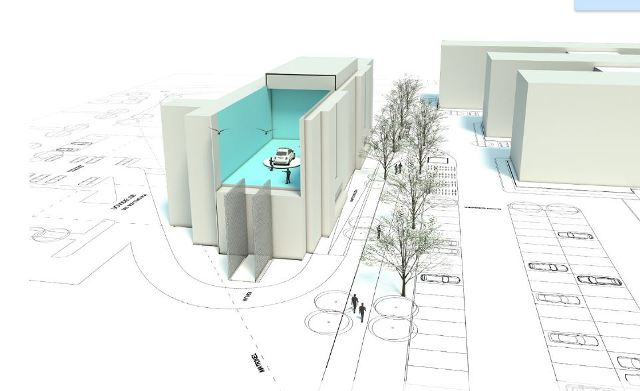Oct 12 2015
The measurement of wireless signals from mobile phones, satellites and drones gets optimal conditions in an unusual new building in Aalborg that NOVI Science Park is constructing for Aalborg University and chip manufacturer Intel's Danish branch.
 Antenna Lab
Antenna Lab
The U.S. Intel already has 250 engineers in Aalborg and they will have access to one of the world's most advanced testing laboratories for the antennas of the future.
The building itself will be unique in many ways. It will have a 140-square-meter roof that can be pushed all the way to the side and a 154-square-meter wall that can be lowered allowing a complete opening to the outside. This is one of the features that makes the construction of the antenna building a demanding task. In return, the plans that Gert Frølund Pedersen, Professor and Research Manager at Aalborg University’s Department of Electronic Systems, has fought for for several years will be fully realized.
- We lack facilities and it has been a problem for us that this has dragged on for so long. But this solution is much better than what we otherwise had on the table. So it has been worth the wait, says Gert Frølund Pedersen, who is known for his expertise on antennas, mobile coverage and smartphone design.
Rain a risk for expensive equipment
The ability to open the new laboratory to the air is vital for uninterrupted quality measurements of wireless technology. This also means that the building is going to be missing some normal load-bearing elements, so instead it must be designed with extremely heavy steel beams from the basement to the ceiling in order to be stable in all kinds of weather. In addition, the movable parts of building must be able to be rolled into place again quickly to protect expensive laboratory equipment if it begins to rain. The goal is for this to happen in just 60 seconds, and this is not the standard for existing door solutions of this size. But the plans are anything but standard.
- The building is technically very challenging, but we wanted to create an even better framework for the partnership between Intel and Aalborg University. Antenna research is already one of the university's areas of expertise, and the laboratory creates the conditions for a host of subcontractors and new students in the city. So it wasn’t difficult for us to say yes to the project, says Jesper Jespersen, Administrative Director of NOVI Science Park that is handling the nearly 5000-square-meter construction.
Ready for 100-meter-high arch
The entire antenna research group of 40 researchers is moving to Aalborg University’s part of the new building. Intel's Danish antenna technology development department will be moving into the other end. The department is currently in Norresundby, but the move puts employees close to colleagues at Intel Mobile Communications Denmark in NOVI Science Park.
The university and the company each get their own part of the building with their own laboratories, but the layout allows for enhanced cooperation between the parties. At the same time, Professor Gert Frølund Pedersen sees the new building as an important step towards the creation of the 100-meter-high arch for technical measurements that the researchers have wanted and made plans for the last few years.
- The arch is not part of the project initially, but some thought has been put into it. For example, we have to be able to open up the entire laboratory space in order to be able to use the arch, and now we have that option. Erecting the arch will require a change in plan, and the funding for this is not in place in this round, says Gert Frølund Pedersen.
Still, Aalborg University is investing heavily in the new antenna laboratory with a large amount in the two-digit million kroner range. The Faculty of Engineering and Science is contributing part of this:
- Unique and up-to-date laboratory facilities are necessary to be able to work with the best industrial partners in an international academic partnership, says Dean Eskild Holm Nielsen.